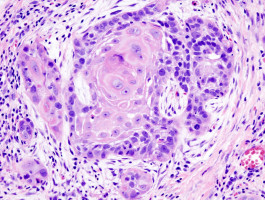
The discovery that the identification and biopsy of the first lymph node to which a cancer spreads (the sentinel node) can lead to more accurate diagnosis and treatment has revolutionised the management of breast cancer.
Now a team of researchers has been able to identify accurately the sentinel node (SN) in head and neck squamous cell carcinoma (HNSCC) using a novel tracer; a challenging task because there are up to 150 different lymph nodes in the neck, and the differentiation of true SNs from secondary nodes is difficult.
The study, reported at the 5th International Conference on Innovative Approaches in Head and Neck Oncology (ICHNO) will reduce significantly the number of HNSCC patients who currently undergo selective neck dissection (SND), a procedure which involves removing a group of lymph nodes from the neck in order to try to eradicate those which may have been reached by the cancer.
“Until recently, surgeons had little choice but to carry out en-bloc surgery of all the soft tissue in a lymph node region, with all the after effects that this entailed for the patient. SN detection and biopsy using conventional tracers may be difficult for some tumour sites, potentially limiting its use. Our current multi-centre pivotal study has shown that in many patients, by using a radiotracer with a novel receptor-based mechanism, the SN can be reliably identified and removed for biopsy without having to undertake more extensive surgery. This means that only patients with metastatic SNs would require extensive surgical treatment,” said Professor Remco de Bree, a head and neck surgeon from the VU University Medical Center, Amsterdam, The Netherlands.
Colleagues from the USA1 carried out a trial in which 83 patients with early stage HNSCC who were all scheduled to undergo neck dissection were injected with the novel tracer, tilmanocept.
They were able to identify and remove at least one SN in 81 patients.
When the results were compared with studies in the literature using standard radiocolloid tracers the researchers found that the SN biopsy using tilmanocept provided a high identification rate and low false negative rate for SNs, thus facilitating accurate prediction of the spread of the cancer.
“Not only was the detection rate of sentinel nodes by tilmanocept high, but it also has other advantages,” Prof de Bree said.
“It is retained longer in the sentinel node – for up to 30 hours – and clears faster from the injection site. These advantages are not confined solely to HNSCC; the tracer may be particularly helpful where the injection site is located very close to the sentinel node, and also in other tumour locations.”
The researchers now plan to start a study in the EU in which patients will undergo SN mapping (lymphoscintigraphy) after injection of both types of radiotracers.
“If we find that lymphoscintigrams using tilmanocept are at least as good as the conventional radiocolloid tracer in identification and visualisation of sentinel nodes, we would like to see a randomised clinical trial involving large numbers of patients,” said Prof de Bree.
Avoiding unnecessary neck dissection is important, not only because of the desire to minimise surgery, but also because the surgery can have significant negative after effects.
Even in selective node dissection, which is carried out in early stage cancer and in which fewer lymph nodes need to be removed, these negative effects can be considerable.
The most common is decreased shoulder mobility with associated pain, but there may also be difficulty in talking or swallowing, and permanent nerve damage and numbness on the side where the surgery has been carried out.
“We believe that we have made an important step forward in minimising post-operative complications for patient with early HNSCC, enabling a more accurate identification of the stage of their disease, and reducing the cost to healthcare systems at the same time,” Prof de Bree concluded.
Professor Jean Bourhis, co-chair of the conference scientific committee, said: “Finding means to minimise the impact of any surgery is important, and particularly so in patients with cancer. This research represents a significant step forward in reducing the complications caused by neck dissection in patients with head and neck tumours.”
Reference
1. The trial was performed in 12 centres in the USA, including MD Anderson Cancer Center Houston, The Ohio State University Comprehensive Cancer Center, and the University of Miami Hospital and Clinics/Sylvester Comprehensive Cancer Center. It was sponsored by Navidea Biopharmaceuticals.
Source: ICHNO 2015
We are an independent charity and are not backed by a large company or society. We raise every penny ourselves to improve the standards of cancer care through education. You can help us continue our work to address inequalities in cancer care by making a donation.
Any donation, however small, contributes directly towards the costs of creating and sharing free oncology education.
Together we can get better outcomes for patients by tackling global inequalities in access to the results of cancer research.
Thank you for your support.